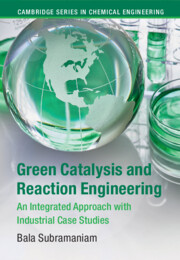Book contents
- Green Catalysis and Reaction Engineering
- Cambridge Series in Chemical Engineering
- Green Catalysis and Reaction Engineering
- Copyright page
- Dedication
- Contents
- Preface
- Acknowledgments
- 1 Sustainability Challenges of the Chemical Industry
- 2 Multiphase Catalytic Processes and Sustainability Challenges
- 3 Ethylene Production from Diverse Feedstocks and Energy Sources
- 4 Ethylene Epoxidation in Gas-Expanded Liquids with Negligible CO2 Formation as a Byproduct
- 5 Spray Reactor-Based Terephthalic Acid Production as a Greener Alternative to the Mid-Century Process
- 6 Sustainability Assessments of Hydrogen Peroxide-Based and Tertiary Butyl Hydroperoxide-Based Propylene Oxide Technologies
- 7 Separation of Propane/Propylene Mixture by Selective Propylene Hydroformylation in Gas-Expanded Liquids
- 8 A Greener Higher Olefin Hydroformylation Process
- 9 Solid Acid-Catalyzed Olefin/Isoparaffin Alkylation in Supercritical Carbon Dioxide
- 10 Epilogue
- Index
- References
9 - Solid Acid-Catalyzed Olefin/Isoparaffin Alkylation in Supercritical Carbon Dioxide
Published online by Cambridge University Press: 15 September 2022
- Green Catalysis and Reaction Engineering
- Cambridge Series in Chemical Engineering
- Green Catalysis and Reaction Engineering
- Copyright page
- Dedication
- Contents
- Preface
- Acknowledgments
- 1 Sustainability Challenges of the Chemical Industry
- 2 Multiphase Catalytic Processes and Sustainability Challenges
- 3 Ethylene Production from Diverse Feedstocks and Energy Sources
- 4 Ethylene Epoxidation in Gas-Expanded Liquids with Negligible CO2 Formation as a Byproduct
- 5 Spray Reactor-Based Terephthalic Acid Production as a Greener Alternative to the Mid-Century Process
- 6 Sustainability Assessments of Hydrogen Peroxide-Based and Tertiary Butyl Hydroperoxide-Based Propylene Oxide Technologies
- 7 Separation of Propane/Propylene Mixture by Selective Propylene Hydroformylation in Gas-Expanded Liquids
- 8 A Greener Higher Olefin Hydroformylation Process
- 9 Solid Acid-Catalyzed Olefin/Isoparaffin Alkylation in Supercritical Carbon Dioxide
- 10 Epilogue
- Index
- References
Summary
Alkylation of 1-butene with isobutane is employed industrially to produce C8 alkylates (such as trimethylpentane) as high-octane motor fuel. Such alkylates supply roughly up to 15% of the U.S. gasoline pool. However, the process uses large quantities of sulfuric acid (as catalyst) generating acid waste whose handling poses health and environmental hazards. The main pollutants are sulfur dioxide (SO2) emissions (which causes acid rain) and acid leakage in the alkylation unit. This chapter presents an alternate process that uses a solid catalyst (Nafion® supported on silica) in dense CO2 media to produce C8 alkylates (solid acid/CO2 process). Although the environmental concerns with SO2 emissions and acid leakage are eliminated, the activity of the solid acid catalyst is lower than sulfuric acid resulting in an approximately 30% higher capital investment than the conventional process. For C8 alkylate productivity, capital investments and operating costs to be nearly identical, the required olefin throughput in the solid acid/CO2 process must be four-fold higher. Such analyses establish performance targets for the solid acid/CO2 process to be commercially viable.
- Type
- Chapter
- Information
- Green Catalysis and Reaction EngineeringAn Integrated Approach with Industrial Case Studies, pp. 189 - 204Publisher: Cambridge University PressPrint publication year: 2022

